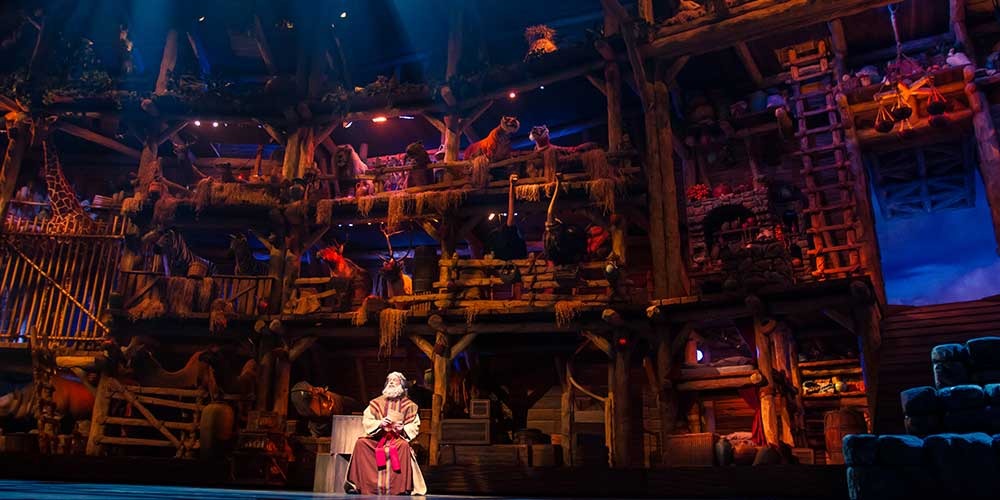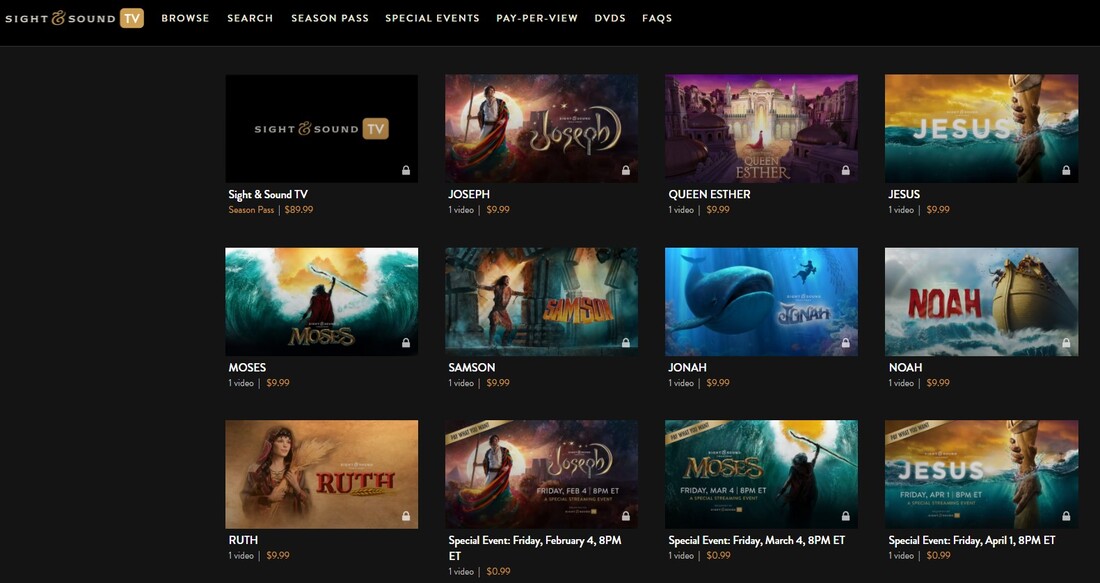Sight and Sound Theatres
Lancaster, Pennsyvlania & Branson, Missouri
Virtual Tour (2022): Chelsea Taylor (Northwestern University)
Sight & Sound Theatres, named after a line from Jesus’s parable of the Sower in the Book of Matthew (Matthew 13:13), is a Christian ministry dedicated to bringing the Bible to life by visualizing and dramatizing scripture. This evangelical theatre company creates spectacular musical adaptations of Bible stories that can be staged at either of their two locations in Lancaster, Pennsylvania, and Branson, Missouri. Each year each site stages one musical from its ever-growing repertoire for a ten-month run, usually opening in March and closing in December.
Sight & Sound Theatres favors the narrative “hits” of the Bible as source material, adapting popular and fantastical stories with recognizable characters that allow for massive spectacle. For example, the musical Moses not only stages the ten plagues of Egypt but also the parting of the Red Sea, while Jonah spotlights a giant whale puppet swimming over the audience’s heads. The casts for these shows regularly number over 50 and often feature trained animals, allowing Sight & Sound Theatres to advertise its shows as “epic experience[s]… where edge-of-your-seat action meets heartfelt drama.”
As a “family-owned, family-led” company, Sight & Sound Theatres maintains the same evangelical mission the company started with in 1964. Founder Glenn Eshleman recounts his humble beginnings presenting DIY-style multimedia presentations at a local church in Lancaster. By 1976, Eshleman and his wife Shirley opened a permanent residence for their multimedia projects and live performances called the Living Waters Theatre; however, their first full-length theatre production Behold the Lamb did not debut until 1987. The steadily growing popularity of their shows allowed the Eshleman family to expand over the decade. In 1997, Sight & Sound Theatres constructed the current Lancaster theatre, complete with a 2,000-seat auditorium and a 300-foot panoramic stage able to house sets up to 40 feet in height. By 2008, the Eshleman family’s operation had branched out even further, opening a nearly identical twin theater in the family-focused vacation destination of Branson, Missouri.
Sight & Sound Theatres, as perhaps the most successful Christian theatre company in the United States, claims to attract up to 1.5 million guests every year. This popularity, in large part, is because Sight & Sound Theatres’ craft their musicals in the image of contemporary megamusicals. The megamusical, a neologism describing an extravagant, large-scale musical developed for commercial profit, emerged as a distinct genre in the 1980s through the massive popularity of shows like Cats (1981), Les Misérables (1985), The Phantom of the Opera (1986), and Miss Saigon (1989). Megamusicals, like Wicked (2003) or Hamilton (2015), still attract thousands of tourists a year to theatrical centers like Broadway in New York City or West End in London. Sight & Sound Theatres’ artists recognize that high-quality production value (seen in elements like large-scale scenography, Disney-esque aesthetics, and consistent branding) give their musicals cultural cachet, minimizing the risk of spectators writing off their shows as cheesy, hokey, or even cringey. By prioritizing professional expertise, they lend legitimacy to the religious messaging, implicitly arguing it is a topic worth the more than $50 price of admission.
While an abundance of Christian theatre exists in the contemporary US, most faith-based theatre projects take the form of community theatre. These DIY-style, low-budget productions take on a similar ethos to the Little Theatre movement of the early twentieth century by framing theatre as a leisure activity in which amateur artists can express themselves, forge new relationships, and communicate their values as a community. Although Sight & Sound Theatres may have started in a similar vein, the organization now stands in stark contrast to this recognizable model due to their successful commercial model and professionalism. Eshelman, in an interview about the mission of Sight & Sound Theatres, argues: “there is a strong need in the world today for this type of ministry. For too long, the world has looked at Christian Drama as bathrobes and half-cut wigs, why should it not be equal to that of Broadway, equal to that in Las Vegas.”
To develop new musicals, Sight & Sound Theatres gather upwards of 100 artists as members of a production team tasked with creating a show from the ground up over the course of three years. This three-year timeline accounts for everything from writing the original book and score and building extravagant sets and costumes to launching a national marketing campaign and running the final dress rehearsal. The most recent example is Sight & Sound Theatres’ production David, which opens March 12, 2022, at the Lancaster location. In addition to the cost of developing new shows, Sight & Sound Theatres regularly updates the technology for their panoramic stages, such as buying two 300-foot, 12-ton LED screens for $1.3 million dollars each for both locations. To ensure a reliable talent pipeline, Sight & Sound Theatres even created a conservatory program to train new actors in professional acting, singing, dancing, and Bible study.
Sight & Sound Theatres most famous musical is, perhaps, its landmark show Noah. Most recently remounted for the thirteenth time since its premiere in 1995 at the Branson, Missouri, location in 2020, Noah continues to maintain audience interest even after twenty-five years. This adaptation spotlights the story of Noah’s Ark as a metaphor for ultimate salvation through belief in Jesus Christ. It also serves as the exemplar of Sight & Sound Theatres’ brand by featuring trained animal performers, large, immersive sets, colorful design aesthetics, and upbeat, joyful music.
More recently, the musical Jesus provides a fresh take on “the greatest story ever told” by turning a collection of parables and miracle stories into an action-packed adventure of Jesus and his closest followers. Opening at the Lancaster location in 2018 and performed in Branson during 2021 and 2022, Sight & Sound Theatres excite audiences by incorporating a wide variety of special effects into this massive spectacle. Notably, this production resists replicating the narrative “norms” of Passion plays, such as primarily foregrounding the extreme violence of the crucifixion, and, instead, spotlights lesser-known stories from the Gospels accounts. For example, Jesus performs the exorcism of Gerasene (Mark 5:1-20; Matthew 8:28-34; Luke 8:26-39) in an extensive scene. Sight & Sound Theatres exhibits its impressive technical prowess by staging Christ casting a legion of demons out of a man and into a herd of pigs that, subsequently, leap off a cliff and drown themselves.
In addition to Noah and Jesus, Sight & Sound Theatres repertoire includes shows like Joseph, Moses, Samson, Ruth, Jonah, Queen Esther, and David. While audiences may have to wait several years to catch live performances of certain productions, Sight & Sound Theatres now offer DVDs of professional recordings of the shows for purchase online and in the gift shop. Recently, the ministry also launched Sight & Sound TV, a streaming service providing recordings of all their shows, exclusive backstage content, and live promotional events.
Sight & Sound Theatres’ musicals remain quintessential examples what cultural studies researcher Joe L. Kincheloe calls “Christotainment,” or the merging of Evangelical Christian messaging with mainstream forms of popular entertainment. The artistic team of Sight & Sound Theatres has perfected the formula of introducing theology through the family-friendly, sanitary form of the megamusical as way to inspire conversion, consistently reminding audiences that the only pathway to eternal life is through Bible-based, Christian belief. Sight & Sound Theatres maintain a similar position to non-denominational Christian churches (an expression of Christian faith popularized by the dramatic rise of megachurches throughout the 20th and 21st centuries), distancing themselves from specific doctrines and denominational affiliations in favor of prioritizing a more universal message of forgiveness and redemption through Christ’s death and resurrection. As a result, these musicals, especially those drawing from Old Testament source material, forego specific claims about the historicity and authenticity, focusing instead on a Christ-centric, allegorical interpretation of the Bible. This perspective differs from other popular Christian tourist destinations grounded in Fundamentalist ministries that argue for a stricter adherence to a literal interpretation of the Bible, such as creationist museums and theme parks. Due to its wholesome, fun-for-the-whole-family brand and this slightly more relaxed and flexible approach to biblical adaptation, Sight & Sound Theatres manages to avoid the political controversy, protests, and scandals that often accompany other large-scale, Christian tourist sites, like the Ark Encounter or the Holy Land Experience.
For Further Information: Taylor, Chelsea (2021), ‘”Jesus, the Ark for Today”: Evangelizing through Sight & Sound Theatres’s Noah’, Studies in Musical Theatre, 15:3, pp. 261-67








